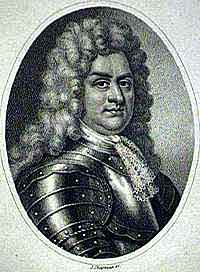
Godart Van Ginkel
1630-1703

![]()
|
GINKEL, GODART VAN (1630-1703), 1st earl of Athlone, Dutch general in the service of England, was born at Utrecht lh 1630. He came of a noble family, and bore the title of Baron van Reede, being the eldest son of Godart Adrian van Reede, Baron Ginkel. In his youth he entered the Dutch army, and in 1688 he followed William, prince of Orange, in his expedition to England. In the following year he distinguished himself by a memorable exploit—the pursuit, defeat and capture of a Scottish. regiment which had mutinied at Ipswich, and was marching northward across the fens. It was the alarm excited by this mutiny that facilitated the passing of the first Mutiny Act. In 1690 Ginkel accompanied William III. to Ireland, and commanded a body of Dutch cavalry at the battle of the Boyne. On the king’s return to England General Ginkel was entrusted with the conduct of the war. He took the field in the spring of 1691, and established his headquarters at Mullingar. Among those who held a command under him was the marquis of Ruvigny, the recognized chief of the Huguenot refugees. Early in June Ginkel took the fortress of Ballymore, capturing the whole garrison of 1000 men. The English lost only 8 men. After reconstructing the fortifications of Ballymore the army marched to Athlone, then one of the most important of the fortified towns of Ireland. The Irish defenders of the place were commanded by a distinguished French general, Saint-Ruth. The firing began on June 19th, and on the 30th the town was stormed, the Irish army retreating towards Galway, and taking up their position at Aughrim. Having strengthened the fortifications of Athlone and left a garrison there, Ginkel led the English, ~on July 12th, to Aughrim. An immediate attack was resolved on, and, after a severe and at one time doubtful contest, the crisis was precipitated by the fall of Saint-Ruth, and the disorganized Irish were defeated and fled. A horrible slaughter of the Irish followed the struggle, and 4000 corpses were left unburied on the field, besides a multitude of others that lay along the line of the retreat. Galway next capitulated, its garrison being permitted to retire to Limerick. There the viceroy Tyrconnel was in command of a large force, but his sudden death early in August left the command in the hands of General Sarsfield and the Frenchman D’Usson. The English came in sight of the town on the day of Tyrconnel’s death, and the bombardment was immediately begun. Ginkel, by a bold device, crossed the Shannon and captured the camp of the Irish cavalry. A few days later he stormed the fort on Thomond Bridge, and after difficult negotiations a capitulation was signed, the terms of which were divided into a civil and a military treaty. Thus was completed the conquest or pacification of Ireland, and the services of the Dutch general were amply recognized and rewarded. He received the formal thanks of the House of Commons, and was created by the king 1st earl of Athlone and baron of Aughrim. The immense forfeited estates of the earl of Limerick were given to him, but the grant was a few years later revoked by the English parliament. The earl continued to serve in the English army, and accompanied the king to the continent in 1693. He fought at the sieges of Namur and the battle of Neerwinden, and assisted in destroying the French magazine at Givet. In 1702, waiving his own claims to the position of commander-in-chief, he commanded the Dutch serving under the duke of Marlborough. He died at IJtrecht on the 11th of February 1703, and was succeeded by his son the 2nd earl (1668—1719), a distinguished soldier in the reigns’ of William III. and Anne. On the death of the 9th earl without issue in 1844, the title became extinct. Battle of Aughrim In June 1691, the Williamite forces under
General Ginkel finally succeeded in crossing the Shannon at Athlone
and the Jacobite army was pushed back from the line of the Shannon.
Galway and Limerick were now the only two substantial towns in Jacobite
hands. A French General called the Marquis de Saint Ruth was put in
charge of the Jacobite Army. He decided to make a stand at the hill
of Aughrim in County Galway. After a heroic fight the Jacobite Army
was finally crushed. Thousands of Jacobite soldiers were killed, including
Saint Ruth. Patrick Sarsfield, the commander of the cavalry gathered
up what remained of the army and retreated to Limerick. Clare Castle It would appear that no substantial military action was fought in County Clare. In order to put a quick end to the war, General Ginkel at this time promised that any Jacobite commander who would surrender a castle or town would not have his lands and property confiscated. It seems that this is what happened in the case of Clare Castle as there is no evidence of a military action having been fought there. And indeed the commander of the garrison, Teige McNamara, was afterwards allowed to retain possession of his Tulla estates. The Siege of Limerick William, prince of orange was married to Mary, and were fighting against JamesII. William and James were in England. William put General Ginkel in command and General St.Ruth was put in command for James army.The first siege was fought in Limerick.William surrounded Limerick ,but he had to wait for great cannons so they could break down the wall.When a cavalry officer called Patrick Sarsfield in James army heard that the weapons were on there way, he called a troop of soldiers together from the city and ambushed the siege train at Ballyneety.Most of the weapons were destroyed at the attack.William failed to capture the city. The next sieges were in Athlone and in Aughrim. The battle of Aughrim was the bloodiest battle in Irish history were St Ruth was killed by a cannon ball. Patrick Sarsfield now became leader and re-treated to Limerick after the battle at Aughrim. Sarsfield defended the city hoping that help would come from France,but no help came so Sarsfield was forced to make an agreement with General Ginkel,This agreement was "The Treaty of Limerick".A few days later a fleet of French ships arrived to help the Jacobites,but Sarsfield wouldn't break his word, so the fleet of ships were sent back. Patrick Sarsfield and his soldiers went to France and more Countries to fight there. They were known as the Wild Geese. Treaty of Limerick The Treaty of Limerick was signed on 3 October 1691. Under it the Irish army was allowed to go to France. The Clare Dragoons were transported to the continent and were later to achieve great distinction and fame on the battle fields of Europe, particularly at the battles of Ramilles and Fontenoy. Confiscation of Lands However the fate of the Jacobite land holders
of Co. Clare was fairly predictable. Any land owner who had supported
James II was attained for high treason and lost his estates. Lord
Clare for example one of the biggest land owners in Co. Clare lost
all his property, over 80,000 statute acres.
|
 |
 |
 |
 |
 |
 |

